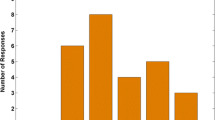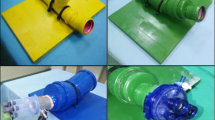Abstract
Background
Natural orifice translumenal endoscopic surgery (NOTES) is a new surgical concept that requires training before it is introduced into clinical practice. The endoscopic–laparoscopic interdisciplinary training entity (ELITE) is a training model for NOTES interventions. The latest research has concentrated on new materials for organs with realistic optical and haptic characteristics and the possibility of high-frequency dissection. This study aimed to assess both the ELITE model in a surgical training course and the construct validity of a newly developed NOTES appendectomy scenario.
Methods
The 70 attendees of the 2010 Practical Course for Visceral Surgery (Warnemuende, Germany) took part in the study and performed a NOTES appendectomy via a transsigmoidal access. The primary end point was the total time required for the appendectomy, including retrieval of the appendix. Subjective evaluation of the model was performed using a questionnaire. Subgroups were analyzed according to laparoscopic and endoscopic experience.
Results
The participants with endoscopic or laparoscopic experience completed the task significantly faster than the inexperienced participants (p = 0.009 and 0.019, respectively). Endoscopic experience was the strongest influencing factor, whereas laparoscopic experience had limited impact on the participants with previous endoscopic experience. As shown by the findings, 87.3% of the participants stated that the ELITE model was suitable for the NOTES training scenario, and 88.7% found the newly developed model anatomically realistic.
Conclusions
This study was able to establish face and construct validity for the ELITE model with a large group of surgeons. The ELITE model seems to be well suited for the training of NOTES as a new surgical technique in an established gastrointestinal surgery skills course.



Similar content being viewed by others
References
Al-Akash M, Boyle E, Tanner WA (2009) Training on NOTES: from history we learn. Surg Oncol 18:111–119
Vick LR, Vick KD, Borman KR, Salameh JR (2007) Face, content, and construct validities of inanimate intestinal anastomoses simulation. J Surg Educ 64:365–368
McDougall EM, Corica FA, Boker JR, Sala LG, Stoliar G, Borin JF, Chu FT, Clayman RV (2006) Construct validity testing of a laparoscopic surgical simulator. J Am Coll Surg 202:779–787
Schijven M, Jakimowicz J (2002) Face, expert, and referent validity of the Xitact LS500 laparoscopy simulator. Surg Endosc 16:1764–1770
Karras DJ (1997) Statistical methodology: II. Reliability and validity assessment in study design. Part B. Acad Emerg Med 4:144–147
Gillen S, Wilhelm D, Meining A, Fiolka A, Doundoulakis E, Schneider A, von Delius S, Friess H, Feussner H (2009) The “ELITE” model: construct validation of a new training system for natural orifice transluminal endoscopic surgery (NOTES). Endoscopy 41:395–399
Ritz JP, Grone J, Hopt U, Saeger HD, Siewert JR, Vollmar B, Lauscher JC, Lehmann KS, Buhr HJ (2009) Practical course for visceral surgery in Warnemunde 10 years on: significance and benefits of a surgical training course. Chirurg 80:864–871
Wilhelm D, Meining A, von Delius S, Fiolka A, Can S, Hann von Weyhern C, Schneider A, Feussner H (2007) An innovative, safe, and sterile sigmoid access (ISSA) for NOTES. Endoscopy 39:401–406
Dunkin BJ (2010) Natural orifice transluminal endoscopic surgery: educational challenge. World J Gastrointest Surg 2:224–230
Meining A, Wilhelm D, Burian M, Dundoulakis M, Schneider A, von Delius S, Feussner H (2007) Development, standardization, and evaluation of NOTES cholecystectomy using a transsigmoid approach in the porcine model: an acute feasibility study. Endoscopy 39:860–864
Park PO, Bergstrom M, Ikeda K, Fritscher-Ravens A, Swain P (2005) Experimental studies of transgastric gallbladder surgery: cholecystectomy and cholecystogastric anastomosis (videos). Gastrointest Endosc 61:601–606
Bernhardt J, Gerber B, Schober HC, Kahler G, Ludwig K (2008) NOTES–case report of a unidirectional flexible appendectomy. Int J Colorectal Dis 23:547–550
Isariyawongse JP, McGee MF, Rosen MJ, Cherullo EE, Ponsky LE (2008) Pure natural orifice transluminal endoscopic surgery (NOTES) nephrectomy using standard laparoscopic instruments in the porcine model. J Endourol 22:1087–1091
Jagannath SB, Kantsevoy SV, Vaughn CA, Chung SS, Cotton PB, Gostout CJ, Hawes RH, Pasricha PJ, Scorpio DG, Magee CA, Pipitone LJ, Kalloo AN (2005) Peroral transgastric endoscopic ligation of fallopian tubes with long-term survival in a porcine model. Gastrointest Endosc 61:449–453
Merrifield BF, Wagh MS, Thompson CC (2006) Peroral transgastric organ resection: a feasibility study in pigs. Gastrointest Endosc 63:693–697
Wagh MS, Merrifield BF, Thompson CC (2006) Survival studies after endoscopic transgastric oophorectomy and tubectomy in a porcine model. Gastrointest Endosc 63:473–478
Kavic MS, Mirza B, Horne W, Moskowitz JB (2008) NOTES: issues and technical details with introduction of NOTES into a small general surgery residency program. JSLS 12:37–45
Rattner D, Kalloo A (2006) ASGE/SAGES Working Group on Natural Orifice Translumenal Endoscopic Surgery. October 2005. Surg Endosc 20:329–333
Meining A, Kahler G, von Delius S, Buess G, Schneider A, Hochberger J, Wilhelm D, Kubler H, Kranzfelder M, Bajbouj M, Fuchs KH, Gillen S, Feussner H (2009) Natural orifices transluminal endoscopic surgery (NOTES) in Germany: summary of the working group reports of the D-NOTES meeting 2009. Z Gastroenterol 47:1160–1167
Semm K (1986) Pelvi-trainer, a training device in operative pelviscopy for teaching endoscopic ligation and suture technics. Geburtshilfe Frauenheilkd 46:60–62
Gallagher AG, Smith CD, Bowers SP, Seymour NE, Pearson A, McNatt S, Hananel D, Satava RM (2003) Psychomotor skills assessment in practicing surgeons experienced in performing advanced laparoscopic procedures. J Am Coll Surg 197:479–488
Tanoue K, Uemura M, Kenmotsu H, Ieiri S, Konishi K, Ohuchida K, Onimaru M, Nagao Y, Kumashiro R, Tomikawa M, Hashizume M (2010) Skills assessment using a virtual reality simulator, LapSim, after training to develop fundamental skills for endoscopic surgery. Minim Invasive Ther Allied Technol 19:24–29
van Dongen KW, Tournoij E, van der Zee DC, Schijven MP, Broeders IA (2007) Construct validity of the LapSim: can the LapSim virtual reality simulator distinguish between novices and experts? Surg Endosc 21:1413–1417
Lehmann KS, Ritz JP, Maass H, Cakmak HK, Kuehnapfel UG, Germer CT, Bretthauer G, Buhr HJ (2005) A prospective randomized study to test the transfer of basic psychomotor skills from virtual reality to physical reality in a comparable training setting. Ann Surg 241:442–449
Seymour NE (2005) Integrating simulation into a busy residency program. Minim Invasive Ther Allied Technol 14:280–286
Seymour NE (2008) VR to OR: a review of the evidence that virtual reality simulation improves operating room performance. World J Surg 32:182–188
Satava RM (2001) Surgical education and surgical simulation. World J Surg 25:1484–1489
Kalloo AN, Singh VK, Jagannath SB, Niiyama H, Hill SL, Vaughn CA, Magee CA, Kantsevoy SV (2004) Flexible transgastric peritoneoscopy: a novel approach to diagnostic and therapeutic interventions in the peritoneal cavity. Gastrointest Endosc 60:114–117
Clark J, Sodergren M, Noonan D, Darzi A, Yang GZ (2009) The natural orifice simulated surgical environment (NOSsE): exploring the challenges of NOTES without the animal model. J Laparoendosc Adv Surg Tech A 19:211–214
Acknowledgments
We thank Marcus Sommer and team from SOMSO for providing the manikin and for the further development of the model. This study was supported Bundesministerium für Wirtschaft und Technologie and AiF.
Disclosure
Sonja Gillen, Jörn Gröne, Fritz Knödgen, Petra Wolf, Michael Meyer, Helmut Friess, Heinz-Johannes Buhr, Jörg-Peter Ritz, Hubertus Feussner, and Kai S. Lehmann have no conflicts of interest or financial ties to disclose.
Author information
Authors and Affiliations
Corresponding author
Rights and permissions
About this article
Cite this article
Gillen, S., Gröne, J., Knödgen, F. et al. Educational and training aspects of new surgical techniques: experience with the endoscopic–laparoscopic interdisciplinary training entity (ELITE) model in training for a natural orifice translumenal endoscopic surgery (NOTES) approach to appendectomy. Surg Endosc 26, 2376–2382 (2012). https://doi.org/10.1007/s00464-012-2165-z
Received:
Accepted:
Published:
Issue Date:
DOI: https://doi.org/10.1007/s00464-012-2165-z




